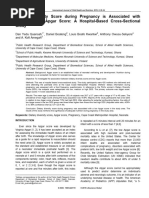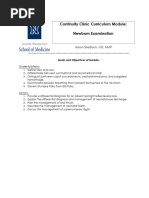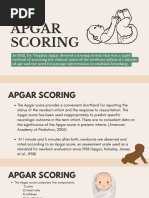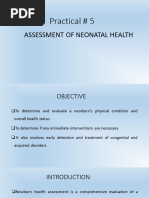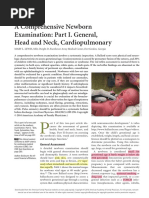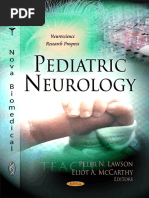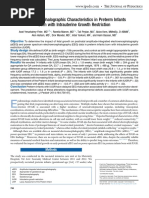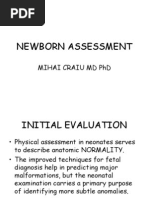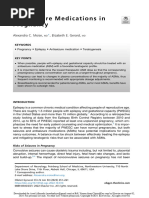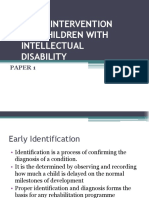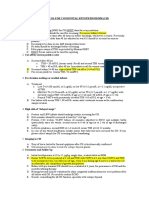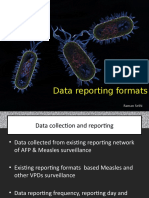Limitations of APGAR Scoring
Limitations of APGAR Scoring
Uploaded by
Fatima Llana TolentinoCopyright:
Available Formats
Limitations of APGAR Scoring
Limitations of APGAR Scoring
Uploaded by
Fatima Llana TolentinoOriginal Description:
Original Title
Copyright
Available Formats
Share this document
Did you find this document useful?
Is this content inappropriate?
Copyright:
Available Formats
Limitations of APGAR Scoring
Limitations of APGAR Scoring
Uploaded by
Fatima Llana TolentinoCopyright:
Available Formats
Limitations of the Apgar ScoreLimitations of the Apgar Score
•The Apgar score is an expression of the infant’s physiologic condition at one point in time, which
includes subjective components.
•There are numerous factors that can influence the Apgar score, including maternal sedation or
anesthesia, congenital malformations, gestational age, trauma, and interobserver variability.
•The biochemical disturbance must be significant before the score is affected. Elements of the score
such as tone, color, and reflex irritability can be subjective, and partially depend on the physiologic
maturity of the infant.
Putting the Apgar score into perspective
“The Apgar score alone cannot be considered to be evidence of or a consequence of asphyxia, does not
predict individual neonatal mortality or neurologic outcome, and should not be used for that purpose.”
-The American Academy of Pediatrics (AAP) and the American College of Obstetricians and Gynecologists
(ACOG)
Limitations of the Apgar Score
There are numerous factors that can influence the Apgar score, including maternal sedation or
anesthesia, congenital malformations, gestational age, trauma, and interobserver variability.
In addition, the biochemical disturbance must be significant before the score is affected.
Conclusions
The Apgar score describes the condition of the newborn infant immediately after birth and, when
properly applied, is a tool for standardized assessment.
It also provides a mechanism to record fetal-to-neonatal transition.
Apgar scores do not predict individual mortality or adverse neurologic outcome. However, based on
population studies, Apgar scores of less than 5 at 5 and 10 minutes clearly confer an increased relative
risk of cerebral palsy, and the degree of abnormality correlates with the risk of cerebral palsy.
Most infants with low Apgar scores, however, will not develop cerebral palsy.
The Apgar score is affected by many factors, including gestational age, maternal medications,
resuscitation, and cardiorespiratory and neurologic conditions.
Elements of the score, such as tone, color, and reflex irritability, can be subjective and partially depend
on the physiologic maturity of the infant.
The score may also be affected by variations in normal transition.
If the Apgar score at 5 minutes is 7 or greater, it is unlikely that peripartum hypoxia–ischemia caused
neonatal encephalopathy.
Monitoring of low Apgar scores from a delivery service may be useful.
Individual case reviews can identify needs for focused educational programs and improvement in
systems of perinatal care.
Analyzing trends allows for the assessment of the effect of quality improvement interventions.
Sources: https://pediatrics.aappublications.org/content/136/4/819
https://utswmed.org/medblog/apgar-score/
You might also like
- Pediatrics History and Physical ExamDocument16 pagesPediatrics History and Physical Examstarrnewmanpa100% (1)
- Post Activity Report I. Details of The Activity: Title of Activity: BAYANIHAN, BAKUNAHAN National COVID-19 Vaccination (2 Dose)Document3 pagesPost Activity Report I. Details of The Activity: Title of Activity: BAYANIHAN, BAKUNAHAN National COVID-19 Vaccination (2 Dose)Pen ZerrudoNo ratings yet
- Breast CareDocument5 pagesBreast CareBhawna Pandhu100% (4)
- Synthesis PaperDocument6 pagesSynthesis Paperapi-252076032No ratings yet
- Apgar ScoreDocument6 pagesApgar Score105070201111009No ratings yet
- The Apgar Score: PediatricsDocument6 pagesThe Apgar Score: PediatricsDiana GarciaNo ratings yet
- ScoreDocument7 pagesScorefernin96No ratings yet
- Jurnal Apgar ScoreDocument4 pagesJurnal Apgar ScoreMaulidianaIndahNo ratings yet
- ApgarDocument13 pagesApgarAneesh MyneniNo ratings yet
- APGAR Score and Ballard Score: K. C. JanakDocument41 pagesAPGAR Score and Ballard Score: K. C. JanakJanak Kc67% (3)
- The Apgar ScoreDocument6 pagesThe Apgar ScoretiuwangNo ratings yet
- Dan Et Al,. 2019 - APGAR ScoreDocument9 pagesDan Et Al,. 2019 - APGAR ScorepppNo ratings yet
- Zisovska-SCORING SYSTEMS IN NEONATOLOGYDocument45 pagesZisovska-SCORING SYSTEMS IN NEONATOLOGYrahermd1971No ratings yet
- Apgar ScoreDocument33 pagesApgar ScoredianavemNo ratings yet
- Five-Minute Apgar Score As A Marker For Developmental Vulnerability at 5 Years of AgeDocument7 pagesFive-Minute Apgar Score As A Marker For Developmental Vulnerability at 5 Years of AgePipit Dwi NurjayantiNo ratings yet
- Newborn ModuleDocument13 pagesNewborn Modulekrf8qbqmmfNo ratings yet
- Apgar ScoreDocument15 pagesApgar ScoreSeema ShasNo ratings yet
- Evaluation of Apgar Score in Neonates Born To Teenage MothersDocument4 pagesEvaluation of Apgar Score in Neonates Born To Teenage MothersMarlie SilmaroNo ratings yet
- Intra Uterine Growth RetardationDocument46 pagesIntra Uterine Growth RetardationIba Ghannam100% (1)
- Apgar Score AssignmentDocument7 pagesApgar Score AssignmentKpiebakyene Sr. MercyNo ratings yet
- AspartylglycosaminuriaDocument2 pagesAspartylglycosaminuriamanasausshoppingNo ratings yet
- NCM 107-Physiologic Function and AppearanceDocument110 pagesNCM 107-Physiologic Function and AppearanceAllyza Montaño Santander GomezNo ratings yet
- Practical 5Document10 pagesPractical 5MARIA TARIQNo ratings yet
- A Comprehensive Newborn Examination Part IDocument8 pagesA Comprehensive Newborn Examination Part ILaura Paola UrquizoNo ratings yet
- Abnormalities of Fetal GrowthDocument55 pagesAbnormalities of Fetal GrowthAbhishek SgNo ratings yet
- The Apgar Score and Its Components in The Preterm Infant: PediatricsDocument7 pagesThe Apgar Score and Its Components in The Preterm Infant: PediatricsSepnitaYantiSitumeangNo ratings yet
- Ca 15Document9 pagesCa 15bostonhopskin3No ratings yet
- CharacteristicsDocument6 pagesCharacteristicsdrnovaisdirNo ratings yet
- Vision Screening in ChildrenDocument4 pagesVision Screening in ChildrenOscar KatamkoNo ratings yet
- It's Time To Reevaluate The Apgar ScoreDocument2 pagesIt's Time To Reevaluate The Apgar ScoreCandy RevolloNo ratings yet
- Articles: Jesrine Hong, Kylie Crawford, Kate Jarrett, Tegan Triggs, and Sailesh KumarDocument12 pagesArticles: Jesrine Hong, Kylie Crawford, Kate Jarrett, Tegan Triggs, and Sailesh Kumarjudith paz villegasNo ratings yet
- Rudiger 2006Document3 pagesRudiger 2006abhishek4aiimsNo ratings yet
- Pediatric Neurology - Lawson Peter N. (SRG)Document200 pagesPediatric Neurology - Lawson Peter N. (SRG)Hriday DeNo ratings yet
- 2018 Marin de Vega M.D.Document9 pages2018 Marin de Vega M.D.arvinkennethdelacruzNo ratings yet
- APGAR Scoring SystemDocument7 pagesAPGAR Scoring SystemOksana KolomiichukNo ratings yet
- Tugas Pertemuan 2 Dan 3 AkbidDocument10 pagesTugas Pertemuan 2 Dan 3 AkbidRena Nana RenaNo ratings yet
- ApgarDocument4 pagesApgarjaysille09100% (1)
- Micro Teaching TopicDocument11 pagesMicro Teaching TopicSiddula JyothsnaNo ratings yet
- Intrauterine Growth Retardation Vol.1 No.8Document5 pagesIntrauterine Growth Retardation Vol.1 No.8Melinda MarianniNo ratings yet
- Electroencephalographic Characteristics in Preterm Infants Born With Intrauterine Growth Restriction 2014 The Journal of PediatricsDocument7 pagesElectroencephalographic Characteristics in Preterm Infants Born With Intrauterine Growth Restriction 2014 The Journal of PediatricsfujimeisterNo ratings yet
- Topicsheet GenetictestingDocument2 pagesTopicsheet GenetictestingRoxy O'HaraNo ratings yet
- Epilepsy in PregnancyDocument52 pagesEpilepsy in PregnancyadityoNo ratings yet
- Detailed Neurologic Assessment of Infants and Children - UpToDateDocument25 pagesDetailed Neurologic Assessment of Infants and Children - UpToDateLeoberto Batista Pereira SobrinhoNo ratings yet
- Rajiv Gandhi University of Health Sciences - Karnataka Bangalore Annexure II: Proforma For Registration of Subject For DissertationDocument14 pagesRajiv Gandhi University of Health Sciences - Karnataka Bangalore Annexure II: Proforma For Registration of Subject For DissertationvenkayammaNo ratings yet
- Research ProposalDocument20 pagesResearch ProposalEnock MutaiNo ratings yet
- Newborn Assessment: Mihai Craiu MD PHDDocument23 pagesNewborn Assessment: Mihai Craiu MD PHDKim TanNo ratings yet
- Health 8 Quarter 2 Lesson 4Document23 pagesHealth 8 Quarter 2 Lesson 4yvannahjean2011No ratings yet
- Retrospective Analysis of Risk Factors For Low 1-Minute Apgar Scores in Term NeonatesDocument10 pagesRetrospective Analysis of Risk Factors For Low 1-Minute Apgar Scores in Term Neonatesputri vinia /ilove cuteNo ratings yet
- Ordaneza - Autism Spectrum DisorderDocument84 pagesOrdaneza - Autism Spectrum DisorderMA. ESPERANZA ORDANEZANo ratings yet
- Apgar ScoreDocument5 pagesApgar ScoreVania IhwanahNo ratings yet
- A Newborn With Low ApgarDocument69 pagesA Newborn With Low ApgarAce LinesNo ratings yet
- Antiseizure Medications in PregnancyDocument11 pagesAntiseizure Medications in PregnancyFaten AklanNo ratings yet
- Apgar Score: How The Test Is PerformedDocument27 pagesApgar Score: How The Test Is PerformedKarl RobleNo ratings yet
- 1º Convulsion Afebril PronosticoDocument2 pages1º Convulsion Afebril PronosticoIliana HernandezNo ratings yet
- Apgar Score 1Document4 pagesApgar Score 1punku1982No ratings yet
- Neonatal Encephalopathy and Neurologic Oute CoDocument9 pagesNeonatal Encephalopathy and Neurologic Oute CoAbdi KebedeNo ratings yet
- Dapus 6Document4 pagesDapus 6Yesi AsrinalNo ratings yet
- Early Intervention For Children With Intellectual DisabilityDocument31 pagesEarly Intervention For Children With Intellectual DisabilitySuellen Concessio Fernandes100% (1)
- Wiki Apgar Score01Document3 pagesWiki Apgar Score01Leevon ThomasNo ratings yet
- APGAR ScoringDocument3 pagesAPGAR ScoringPerez JemaicaNo ratings yet
- 933 FullDocument9 pages933 FullGaurav MedikeriNo ratings yet
- Living With Aspergers Syndrome: ASD or DSM 5 Aspergers in kids, teens, girls/women & adults with long term autism or high functioning asperger behavior symptoms, signs, test diagnosing & treatmentsFrom EverandLiving With Aspergers Syndrome: ASD or DSM 5 Aspergers in kids, teens, girls/women & adults with long term autism or high functioning asperger behavior symptoms, signs, test diagnosing & treatmentsRating: 3 out of 5 stars3/5 (2)
- Vaccine Stock Card Format FINAL 1Document22 pagesVaccine Stock Card Format FINAL 1Aleiah Jean Libatique100% (1)
- Reaction Paper No 6Document2 pagesReaction Paper No 6XyZa EdlarecilNo ratings yet
- Pertussis Immunization in The Global Pertussis.17Document6 pagesPertussis Immunization in The Global Pertussis.17Feylens Delfiga LopulisaNo ratings yet
- Aims and Objective of Expanded Program of ImmunizationDocument18 pagesAims and Objective of Expanded Program of Immunizationpaperpin27100% (2)
- Aap 2011 Vaccine Coding ChangesDocument9 pagesAap 2011 Vaccine Coding ChangestimvrghsNo ratings yet
- Open Vial Policy - 15th Feb 2013Document4 pagesOpen Vial Policy - 15th Feb 2013drnareshchauhanNo ratings yet
- Guru 1 DoseDocument1 pageGuru 1 DoseDj GuruNo ratings yet
- Basic Concepts Dysmorphology Temtamy 2013 PDFDocument62 pagesBasic Concepts Dysmorphology Temtamy 2013 PDFAlberto Garcia DornelasNo ratings yet
- Piis1036731421001144 PDFDocument7 pagesPiis1036731421001144 PDFvaloranthakam10No ratings yet
- MyChart - Health SummaryDocument2 pagesMyChart - Health SummaryCharles VieiraNo ratings yet
- Biology Project: Vidyagyan School Suraincha, Sitapur (U.P.)Document17 pagesBiology Project: Vidyagyan School Suraincha, Sitapur (U.P.)ma2986No ratings yet
- Moderno CIPE JPS 2015Document9 pagesModerno CIPE JPS 2015Valmir MouraNo ratings yet
- (Official) SBI Consent - Waiver Form 2024 (DOWNLOAD A COPY)Document6 pages(Official) SBI Consent - Waiver Form 2024 (DOWNLOAD A COPY)melvert.mataNo ratings yet
- Daftar Pustaka PertusisDocument1 pageDaftar Pustaka PertusisErica PuteriNo ratings yet
- HUBUNGAN FREKUENSI PEMBERIAN ASI TERHADAP KEJADIAN IKTERUS FISIOLOGIS PADA BAYI BARU LAHIR DI SEMEN PADANG HOSPITAL LisnaDocument10 pagesHUBUNGAN FREKUENSI PEMBERIAN ASI TERHADAP KEJADIAN IKTERUS FISIOLOGIS PADA BAYI BARU LAHIR DI SEMEN PADANG HOSPITAL LisnaLizna ZiezieNo ratings yet
- Epi and Cold ChainDocument3 pagesEpi and Cold ChainShadrackNo ratings yet
- Biology Project 88Document11 pagesBiology Project 88Ayush SinghNo ratings yet
- Immediate download Endocrinology 2 Volume Set Adult and Pediatric 6th Edition J. Larry Jameson ebooks 2024Document81 pagesImmediate download Endocrinology 2 Volume Set Adult and Pediatric 6th Edition J. Larry Jameson ebooks 2024paskoweaam3i100% (4)
- PCEP Book 1 Maternal and Fetal Evaluation and Immediate NewbornDocument360 pagesPCEP Book 1 Maternal and Fetal Evaluation and Immediate Newbornناصر العريبيNo ratings yet
- Protocol For Congenital HypothyroidismDocument1 pageProtocol For Congenital HypothyroidismAgnimitra ChoudhuryNo ratings yet
- 10 Reporting Formats HP Oct2017Document65 pages10 Reporting Formats HP Oct2017Devendra Singh Tomar100% (1)
- List of Diseases of Persons in The Endosulfan Victims ListDocument5 pagesList of Diseases of Persons in The Endosulfan Victims ListDr KMSreekumarNo ratings yet
- Proposal Delegates 2019 PDFDocument38 pagesProposal Delegates 2019 PDFIda Ayu GabriellaNo ratings yet
- Practical Neonatology For MRCPCH and BeyondDocument23 pagesPractical Neonatology For MRCPCH and BeyondGhada Hussein0% (1)
- MR 56Document3 pagesMR 56Daniela FernandaNo ratings yet
- Blunt Abdominal Trauma in Children, 2019.Document132 pagesBlunt Abdominal Trauma in Children, 2019.Alexis Fernando PasaribuNo ratings yet











